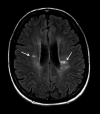An update on immunopathogenesis, diagnosis, and treatment of multiple sclerosis
- PMID: 26445701
- PMCID: PMC4589809
- DOI: 10.1002/brb3.362
An update on immunopathogenesis, diagnosis, and treatment of multiple sclerosis
Abstract
Background: Multiple sclerosis is an acquired demyelinating disease of the central nervous system. It is the second most common cause of disability in adults in United States after head trauma.
Discussion: The etiology of MS is probably multifactorial, related to genetic, environmental, and several other factors. The pathogenesis is not fully understood but is believed to involve T-cell-mediated inflammation directed against myelin and other related proteins with a possible role for B cells. The McDonald criteria have been proposed and revised over the years to guide the diagnosis of MS and are based on clinical presentation and magnetic resonance imaging (MRI) of the brain and spinal cord to establish dissemination in time and space. The treatment of MS includes disease modification with immunomodulator drugs and symptom management to address the specific symptoms such as fatigue, spasticity, and pain.
Conclusion: An update on etiology, pathogenesis, diagnosis, and immunomodulatory treatment of MS is presented.
Keywords: Demyelination; diagnosis; etiology; immunomodulator; multiple sclerosis; pathogenesis; treatment.
Figures



References
-
- Aichele P, Bachmann MF, Hengartner H. Zinkernagel RM. Immunopathology or organ-specific autoimmunity as a consequence of virus infection. Immunol. Rev. 1996;152:21–45. - PubMed
-
- Ascherio A. Environmental factors in multiple sclerosis. Expert Rev. Neurother. 2013;13:3–9. - PubMed
-
- Ascherio A. Munger KL. Environmental risk factors for multiple sclerosis. Part I: the role of infection. Ann. Neurol. 2007a;61:288–299. - PubMed
-
- Ascherio A. Munger KL. Environmental risk factors for multiple sclerosis. Part II: noninfectious factors. Ann. Neurol. 2007b;61:504–513. - PubMed
-
- Ascherio A, Munger KL. Simon KC. Vitamin D and multiple sclerosis. Lancet Neurol. 2010;9:599–612. - PubMed
Publication types
MeSH terms
LinkOut - more resources
Full Text Sources
Other Literature Sources
Medical

